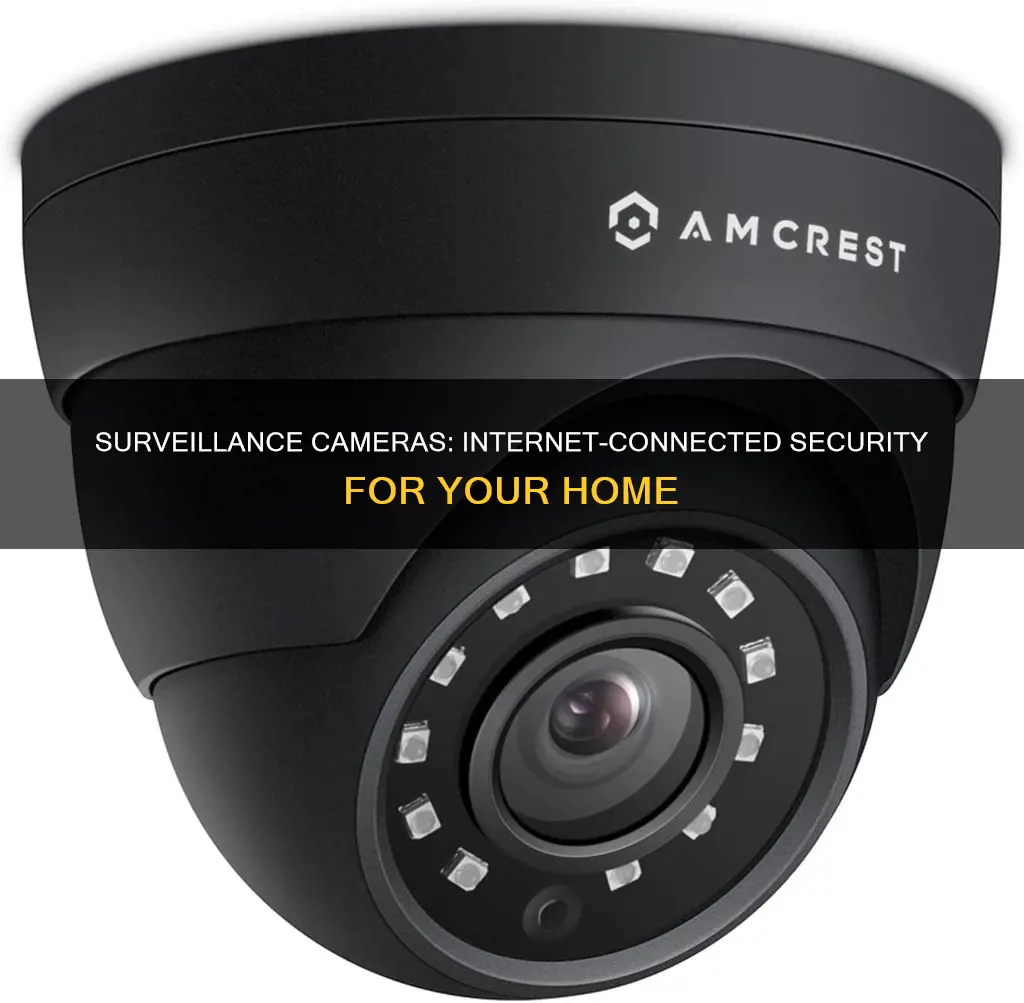
Internet surveillance cameras, or IP cameras, are a type of digital video camera that can be used to monitor a property or location. They connect to the internet or a local area network (LAN) and can transmit footage and data in real-time. IP cameras are often used for security and surveillance purposes, and can be installed in both residential and commercial properties. These cameras offer features such as motion detection, night vision, and cloud or local storage for recorded footage. They can be accessed and controlled remotely, providing live video feeds that can be viewed and monitored from anywhere in the world.
What You'll Learn
- Internet Protocol (IP) cameras can be used for surveillance without an internet connection
- IP cameras can be webcams or require a local area network
- IP cameras can be fixed, varifocal, or pan–tilt–zoom (PTZ)
- Wireless security cameras can work without the internet
- IP cameras can be used for enterprise and consumer surveillance

Internet Protocol (IP) cameras can be used for surveillance without an internet connection
Internet Protocol (IP) cameras are a type of digital video camera that can be used for surveillance. They can be wired or wireless, and unlike analogue closed-circuit television (CCTV) cameras, they do not require a local recording device. IP cameras can be used without an internet connection, but their functionality will be limited. When not connected to the internet, features like cloud storage integration and remote streaming are not possible. However, IP cameras can still capture video footage and offer basic surveillance capabilities without an internet connection.
IP cameras can be connected directly to a computer via an Ethernet cable, creating a local area network (LAN). This allows the camera to communicate with other devices on the network, such as a monitor or a network video recorder (NVR). The footage can be viewed and monitored in real-time on a connected device, and it can also be stored locally on an SD card or the NVR. This makes IP cameras suitable for use in areas without internet access, such as remote farms, cabins, or rural homes.
IP cameras can also be hardwired into an NVR's Power over Ethernet (PoE) switch. The NVR has its own integrated network, allowing it to operate independently of any external LAN. The NVR can be connected to a display and a power source, providing access to the camera feeds without an internet connection. This setup offers a more secure and reliable surveillance system as it is less susceptible to interference and has a more stable data transmission.
While IP cameras can function without an internet connection, they may have limited features compared to when they are connected to the internet. However, they still provide basic surveillance capabilities and can be suitable for use in various environments, including small homes, offices, construction sites, and ranches. For installers and users who require "off-the-grid" surveillance solutions, IP cameras offer a simple and effective option that can be easily integrated into a larger security system.
Finding the Camaro's Battery: Fifth Generation
You may want to see also

IP cameras can be webcams or require a local area network
Internet Protocol (IP) cameras are digital video cameras that can be used for surveillance. They are often used with network video recorders (NVRs) and sometimes digital video recorders (DVRs), making them a common solution for surveillance. IP cameras can be connected to a network through Wi-Fi or a Power over Ethernet (PoE) cable.
IP cameras are different from analog closed-circuit television (CCTV) cameras in that they require no local recording device, only a local area network. This means that IP cameras can be directly accessed over a network connection, making them a good choice for remote monitoring of homes or businesses.
Most IP cameras are webcams, but not all. The term IP camera or netcam is usually applied to cameras that can be directly accessed over a network connection. These cameras can be connected to a network wirelessly or through an Ethernet cable. Wireless IP cameras connect to a Wi-Fi router to send video data, while wired IP cameras use an Ethernet cable to supply both electrical power and data.
IP cameras offer many advantages over traditional analog CCTV cameras, such as higher resolution, remote viewing, and scalability. They also have advanced features such as facial recognition, instant video sharing, and edge-based video analytics. However, setting up an IP camera can be a challenge for those who are not familiar with network configuration and the options available.
OnePlus Camera Upgrades: Significant Improvements or Minor Changes?
You may want to see also

IP cameras can be fixed, varifocal, or pan–tilt–zoom (PTZ)
Internet surveillance cameras, or IP cameras, are digital video cameras that can be used to monitor indoor or outdoor spaces. They are often used for security and surveillance purposes, as well as for live streaming. IP cameras can be categorised into three types: fixed, varifocal, or pan–tilt–zoom (PTZ).
Fixed IP cameras have an immobile perspective and provide a single view within the camera's field of vision. They are commonly used both outdoors and indoors, often in retail stores and business offices.
Varifocal cameras can remotely adjust the zoom of the image. They are useful for capturing details from a distance.
PTZ cameras, on the other hand, can adjust their field of view and angle remotely, allowing users to track events with greater control. They are ideal for monitoring large areas and are commonly used in public outdoor spaces. PTZ stands for pan, tilt, and zoom, referring to the camera's ability to rotate left and right, tilt up and down, and zoom in and out. They are typically used to monitor wide-open areas that require a 180- or 360-degree view. PTZ cameras can be set to automatically follow motion-triggered activity or adhere to a pre-set schedule. They are usually implemented alongside a larger surveillance system, working in tandem with fixed cameras that capture detailed shots.
PTZ cameras provide maximum control over the camera's field of view, enhancing the monitoring of larger areas. They allow operators to investigate moving subjects and capture comprehensive footage across large spaces. However, they may also suffer from command latency, which is the lag time between the operator issuing a command and the camera adjusting its field of view. Additionally, PTZ cameras may have higher costs compared to other options, as they are more expensive to manufacture.
Understanding Raw Image Files in Photography
You may want to see also

Wireless security cameras can work without the internet
Internet surveillance cameras are digital video cameras that send and receive footage over the internet or a local area network (LAN). They are commonly used for surveillance and can be accessed remotely.
There are some wireless security cameras that offer more advanced features without an internet connection. For example, some cameras connect to the internet via a cellular network and offer features such as cloud video recording, remote livestreaming, and alert notifications. However, these cameras tend to be more expensive and may require additional data plan fees.
If you're looking for constant recording and don't need remote access or live streaming, a wired security camera system might be a better option. These systems use cameras that are hardwired into your home and record footage locally. They can provide the same level of protection as wireless cameras but may be more difficult to install and will result in having wires throughout your home.
Overall, while wireless security cameras can work without the internet, their functionality will be limited. If you're looking for more advanced features, you'll need to connect your cameras to the internet either through Wi-Fi or a cellular network.
Mastering Pixel Camera Focus: Tips for Sharp Photos
You may want to see also

IP cameras can be used for enterprise and consumer surveillance
Internet Protocol (IP) cameras are digital video cameras that can be used for both enterprise and consumer surveillance. They are often used for surveillance but, unlike analog CCTV cameras, they don't require a local recording device. IP cameras can be accessed remotely and typically connect to a network through Wi-Fi or a Power over Ethernet (PoE) cable.
Consumer IP cameras are commonly used for home security and can be easily self-installed. They usually send live video to a companion app on a user's device and can be controlled through this app. Features such as wide-angle lenses, night vision, and motion detection are often included.
Enterprise IP cameras are generally used for more large-scale surveillance and offer higher video resolution and advanced video analytics. They are often used in government buildings and traffic intersections. They are also more secure than consumer IP cameras and provide better protection from hacking and malware.
IP cameras have become increasingly popular for both enterprise and consumer use due to their advanced features and ease of installation.
Blinding Surveillance Cameras: Long-Range Methods for Privacy Protection
You may want to see also
Frequently asked questions
An Internet Surveillance Camera, or IP camera, is a digital video camera that connects to a network and sends/receives data over the internet or a local area network (LAN).
IP cameras capture video footage and transmit it over a Wi-Fi or Ethernet connection. They can be configured to store footage on a local hard drive, micro-SD card, or in the cloud.
IP cameras offer several advantages over traditional CCTV cameras, including higher video quality, remote accessibility, motion detection, and advanced features such as facial recognition.
IP cameras are commonly used in government buildings, traffic intersections, retail stores, and business offices. They are also increasingly used in home security systems.
There are several types of IP cameras, including PTZ (pan-tilt-zoom), fixed, PoE (Power over Ethernet), and wireless IP cameras. Each type offers unique features and is suitable for different surveillance needs.







